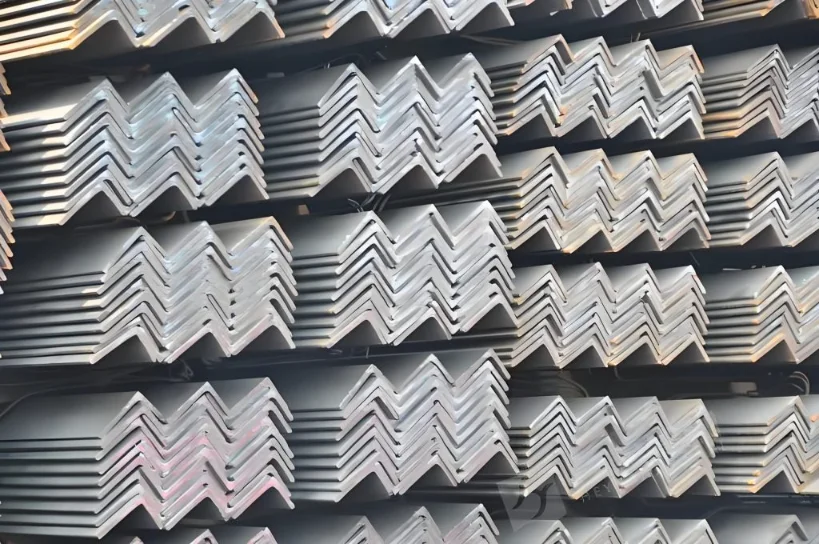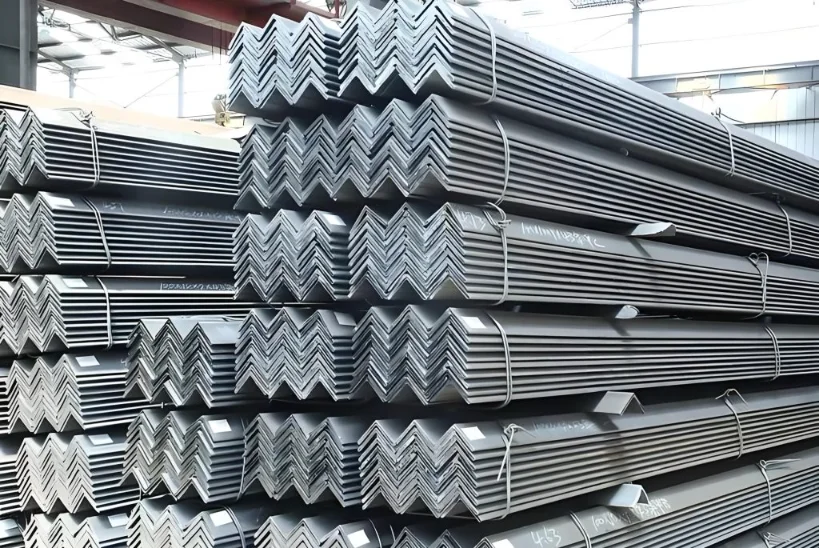
Selecting a structural angle is not just about a size on a chart. It is a trade-off between strength, weight, weld behavior, and price. This guide zeros in on A36 angle steel and puts it next to common high-strength grades, so you can tell—quickly and with confidence—when A36 is enough and when a higher grade actually saves you trouble.
Why Does Grade Selection Matter?
Grade drives yield strength, price, and how cleanly a part welds or bends. Most general fabrication, platforms, frames, racks, and guards do not live at the edge of capacity. They need predictable behavior, steady availability, and fair cost. That is exactly where A36 sits as a low-carbon structural steel that fabricates cleanly and is widely stocked.
If drawings do not push span, deflection, or fatigue limits, A36 often wins on availability and simple fabrication. When spans lengthen or weight targets get tight, the A36 vs high-strength steel comparison becomes the real question and shifts the focus to stiffer sections or higher yield grades you can actually source.
ASTM A36 Composition and Mechanical Properties
A36 is a mild steel with carbon typically up to about 0.26%. That keeps it friendly for cutting, drilling, bending, and welding. Typical yield sits near 36,000 psi, about 250 MPa, with tensile strength in the 58,000 to 80,000 psi range. For angle profiles, that gives enough ductility for fit-ups and site tweaks, while still carrying routine service loads in short to mid spans.
Availability and Cost in Real Projects
Stockists carry A36 angles in a wide spread of leg sizes and thicknesses, so lead times tend to be short. That matters when a change order lands late in the week. In racking, light equipment frames, and access structures, time saved in procurement and fabrication often outweighs the theoretical gain from stepping up to a higher-strength grade.
How Does A36 Compare With High-Strength Grades?
You see the same pattern across shops: use A36 as the default; step up only when spans run long, loads cycle hard, or weight goes critical. If a drawing calls for tighter deflection or mass reduction, higher-strength grades can earn their keep. Otherwise, A36 stays practical and predictable.
A36 vs A572 Grade 50
Step up to Grade 50 when you need yield around 345 MPa to control deflection at the same leg size; stay with A36 when loads are mostly static, spans are short to medium, and you value clean welding and ready stock. Gr 50 can reduce section weight for the same capacity, but that advantage must justify the cost and any added care in welding or forming procedures.
A36 vs Q345 and SS400
Q345 sits in the same strength neighborhood as A572 Gr 50 and is common where regional standards apply. SS400 sits closer to A36 in strength and is used in general structural work. If you are sourcing across regions, match the project’s specified standard and confirm shop procedures for weld and bend windows. When you need one source for multiple specs, the main site navigation helps you pick by standard and finish.
When Is A36 Strong Enough?
Think in plain categories. Short to medium spans with static loads make a clear case for A36. Platforms, guardrails, conveyor supports, shelving, skids, light mezzanines—these are routine A36 territory. You still apply proper safety factors and check connection details. In shops that track downtime, the “strong enough, easy to weld, ships fast” trio often beats chasing small weight savings.
Typical Use Cases You See Weekly
- Warehouse racking and shelf frameworks where leg sizes stay modest and loads are well known
- Small support frames and machine bases that need tack-weld adjustments on site
- Access stairs and platforms with predictable live loads and conservative spans
When Should You Step Up To High-Strength Steel?
Move up when design demands it. Long spans where deflection limits are tight, brackets with repetitive impact, crane runway bracing, or locations where mass targets are strict—those cases may justify higher yield grades. One more flag is harsh environments. If the job lives near the coast or in chemical mist, corrosion protection decisions become just as critical as strength selection.
Practical Triggers For A Higher Grade
- Deflection checks fail with A36 at the planned leg and thickness
- Fatigue loading from machinery or traffic calls for higher yield and better S-N response
- Weight targets from transport or lifting plans force a lighter section
What Sizes and Weights Should You Keep Handy?
A quick reference helps when you are marking up a cut list. The theoretical mass uses a steel density of 7.85 g per cubic centimeter and accounts for equal and unequal legs. Mill tolerances will shift results a bit, so treat these as planning values.
Equal Angle Reference
- 40 × 40 × 4 mm ≈ 2.37 kg per meter
- 50 × 50 × 5 mm ≈ 3.73 kg per meter
- 63 × 63 × 6 mm ≈ 5.54 kg per meter
- 75 × 75 × 6 mm ≈ 6.67 kg per meter
- 90 × 90 × 8 mm ≈ 10.4 kg per meter
Unequal Angle Reference
- 50 × 30 × 5 mm ≈ 3.01 kg per meter
- 63 × 40 × 6 mm ≈ 4.96 kg per meter
- 75 × 50 × 6 mm ≈ 6.02 kg per meter
- 90 × 56 × 8 mm ≈ 9.30 kg per meter
- 100 × 63 × 8 mm ≈ 10.5 kg per meter
How Do You Decide Between A36 And A Higher Grade?
Start with the load case and geometry. If your model shows healthy margins on A36, keep it simple. When the design sits near limits, test a higher grade in the same leg size to see if deflection and connection forces land in a cleaner spot. Weigh the price difference against fabrication time and availability. A small spreadsheet session early saves a long Saturday in the shop.
A Quick, Plain Process
- Run the span and load with A36 and check deflection and stress.
- If margins look thin, try a higher grade at the same size, then compare weight and cost.
- Lock corrosion protection early; coating choices affect fit-up and schedule.
- Confirm shop welding procedures for the final grade to avoid requalification surprises.
- As a sanity check, keep the phrase when to use A36 steel in mind: adequate capacity, simpler welding, faster procurement.
Where Can You Learn More And Get A Quote?
Qingdao Sunrise New Material Co., Ltd. delivers structural steel angles with steady quality control, practical stock planning, and clear documentation. If you want a quick, human walk-through—sizes on the phone, quick drawings, and a written quote—use the site’s contact gateway for a prompt reply: Contact. If you plan to compare other sections or finishes, the catalog paths on the Products page make it straightforward. You get equal and unequal legs, standard mill lengths, and cut-to-size service for tight schedules. Inspection records are available, and weldability data aligns with what fabricators expect for mild and structural grades. The team works from drawings and load notes, not just item codes, which cuts back-and-forth on specs. If the project needs galvanized or painted finish, coordination happens in one place, so you are not juggling multiple vendors. That combination—stock range, paperwork clarity, and service speed—fits repeat industrial work where missed dates cost real money.
FAQ
Q1: When Is A36 Angle Steel Enough For Structural Frames?
A: When spans are short to medium, loads are mostly static, and deflection limits are easy to meet. In those cases, A36 balances strength, weld behavior, and cost without slowing fabrication.
Q2: What Is the Main Difference In An A36 vs High-Strength Steel Comparison?
A: Higher-strength grades lift yield to about 345 MPa and above, which helps on longer spans or weight-critical builds. A36 stays better for general fabrication where availability and simple welding matter more.
Q3: Does A36 Need Galvanizing In Coastal Projects?
A: In marine or salt-spray zones, yes, specify galvanizing or a coating system. Strength selection and corrosion protection are separate decisions, and both affect service life.
Q4: Can You Bend A36 Angle Without Special Procedures?
A: A36 is a mild steel, so standard shop bending practices apply. Check leg thickness, internal radius, and any coating plan before forming to avoid cracking or extra rework.
Q5: Where Can You Buy A36 Angle Steel And Compare Sizes?
A: Browse the product page for A36 angle steel and related sections, then request a cut list or quote through the site. For fast decisions, the homepage and contact links in this guide point to the right place.







